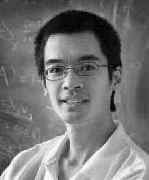Person: Tao, Terence Chi-Shen

Terence Tao won a Fields Medal in 2006 for his contributions to partial differential equations, combinatorics, harmonic analysis and additive number theory.
Mathematical Profile (Excerpt):
- Grace Tao taught physics, chemistry, science and mathematics in various secondary schools in Hong Kong before she emigrated to Australia and, once in Australia, also taught in secondary schools there.
- Terence was small, even for a seven-year-old.
- is more one of guiding and stimulating Terence's development than one of teaching him.
- She said that Terence likes to read mathematics by himself, and he often spent three or four hours after school reading mathematics textbooks.
- Tao undertook research at Princeton University advised by Elias Stein.
- Following the award of his doctorate, Tao was appointed Hedrick Assistant Professor at the University of California at Los Angeles, a position he held from 1996 to 1998.
- It is very difficult to write a biography of someone who is at the height of their creative powers as Tao is.
- He combines sheer technical power, an other-worldly ingenuity for hitting upon new ideas, and a startlingly natural point of view that leaves other mathematicians wondering, " Why didn't anyone see that before?" At 31 years of age, Tao has written over eighty research papers, with over thirty collaborators, and his interests range over a wide swath of mathematics, including harmonic analysis, nonlinear partial differential equations, and combinatorics.
- The Press Release which announced the award of the Fields Medal to Tao listed his accomplishments in a number of areas which had led to the award of this most prestigious mathematical award.
- An area to which Tao has made many contributions is that of the Kakeya problem.
- Tao has worked on the nnn-dimensional Kakeya problem where again the minimum volume can be made as small as one chooses, but the fractal dimension of the shape is unknown.
- Another area in which Tao has worked is solving special cases of the equations of general relativity describing gravity.
- Imposing cylindrical symmetry on the equations leads to the "wave maps" problem where, although it has yet to be solved, Tao's contributions have led to a great resurgence of interest since his ideas seem to have made a solution possible.
- Another area where Tao has introduced novel ideas, giving the subject a whole new look, is the theory of the nonlinear Schrödinger equations.
- These equations have considerable practical applications and again Tao's insights have shed considerable light on the behaviour of a particular Schrödinger equation.
- One might imagine that with his remarkable output of research papers, Tao would not find time to write books.
- In 2006 Tao published a 2-volume textbook Analysis.
- Also in 2006, Tao published Nonlinear dispersive equations.
- But, amazingly, this still does not complete the list of Tao's 2006 books for in that year, in collaboration with Van Vu, he published Additive combinatorics.
- It will come as no surprise to learn that Tao, who is such an innovator in everything he does, has created a new style of book.
- In 2008 Tao published the book Structure and randomness.
- A medium that is particularly well suited to this is the blog, and the undisputed king of all mathematics blogs, with thousands of regular readers, is that of Terence Tao.
- Tao's mathematical knowledge has an extraordinary combination of breadth and depth: he can write confidently and authoritatively on topics as diverse as partial differential equations, analytic number theory, the geometry of 3-manifolds, nonstandard analysis, group theory, model theory, quantum mechanics, probability, ergodic theory, combinatorics, harmonic analysis, image processing, functional analysis, and many others.
- It has been said that Hilbert was the last person to know all of mathematics, but it is not easy to find gaps in Tao's knowledge, and if you do then you may well find that the gaps have been filled a year later.
- Now, in an interesting experiment, several of Tao's blog posts have been tidied up (partly in response to comments from others on the posts) and published as books.
- In 2010 the next in Tao's series was published An epsilon of room, I: real analysis.
Born 17 July 1975, Adelaide, South Australia, Australia.
View full biography at MacTutor
Tags relevant for this person:
Prize Clay Research Award, Prize Fields Medal, Origin Australia
Thank you to the contributors under CC BY-SA 4.0! 

- Github:
-

- non-Github:
- @J-J-O'Connor
- @E-F-Robertson
References
Adapted from other CC BY-SA 4.0 Sources:
- O’Connor, John J; Robertson, Edmund F: MacTutor History of Mathematics Archive
